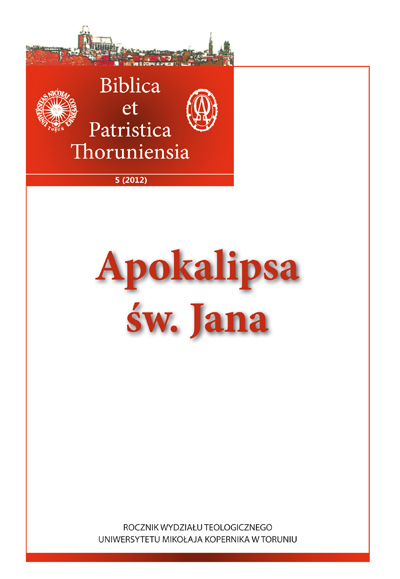Greek influences in the Revelation of John
DOI:
https://doi.org/10.12775/BPTh.2012.006Keywords
Revelation of John, hellenisation of Christianity, Greek influences in the Bible, apocalypticism, mythologyAbstract
Greek influences on the Revelation of John are related to the Hellenistic inspirations of the apocalypticism, which are visible in Daniel and other apocalypses. Their visionary elements and their interest in the future are closer to the Greek perception of the prophecy than to the Hebrew tradition. More detailed influenced can be found in Rev 1.4,8 (description of God); Rev 1.12-20 (Helios imagery, keys, astral symbolism); 666 could result from a gematria. Mythical inspirations include portraying angels and other beings (Rev 6.8; 9.1; 16.4-7; 20.13-14); modeling Rev 12 after the myths on cosmic fight and divine births (especially Apollo and Python); apocalyptic beasts similar to mythical animal hybrids (Rev 13; with Nero redux story and legends on moving statues). Currents opinions on the structures and elements of the world are reflected in Rev 5.13; 16. Platonic, Stoic and Pythagorean inspirations are possible. The author adapted freely pagan imagery, but without modifying his theology.References
Andresen C., Antike und Christentum, „Theologische Realenzyklopadie”, t. 3, 1978, s. 50–99.
Aune D. E., Revelation, t. 1–3, Word Biblical Commentary 52A–C, Dallas 1997–1998.
Aune D. E., The New Testament in Its Literary Environment, Cambridge 1988.
Barrett C. K. (red.), The New Testament Background. Writings from Ancient Greece and the Roman Empire That Illuminate Christian Origins, London 1987.
Beale G. K., The Book of Revelation (New International Greek Testament Commentary), Grand Rapids-Carlisle 1999.
Berger K., Hellenistische Gattungen in Neuen Testament, ANRW II/25.2 (1984): 1031–1432, 1832–1885.
Betz H. D., Antiquity and Christianity, JBL 117 (1998)1, s. 3–23.
Betz H. D., The Birth of Christianity as a Hellenistic Religion: Three Theories of Origin, “Journal of Religion”74 (1994), s. 1–25.
Böcher O., Hellenistisches in der Apokalypse des Johannes, w: Geschichte – Tradition –Reflexion, Fs. M. Hengel, t. 3, red. H. Lichtenberger, Tubingen 1996, s. 473–492.
Busch P., Der gefallene Drache. Mythenexegese am Beispiel von Apokalypse 12, Texte und Arbeiten zum neutestamentlichen Zeitalter 19, Tubingen 1996.
Clemen C., Religionsgeschichtliche Erklarung des Neuen Testaments, Berlin 1924.
Colish M . L., Stoicism and the New Testament, ANRW II/26.1 (1992), 334–379.
Collins J. J., Between Athens and Jerusalem, wyd. 2, Grand Rapids 2000.
Dormeyer D., Das Neue Testament im Rahmen der antiken Literaturgeschichte, Darmstadt 1993.
Feldman L. H., Jew and Gentile in the Ancient World, Princeton 1996.
Hengel M., Judentum und Hellenismus, wyd. 2, Tubingen 1973 (przekład ang. z 1974, Judaism and Hellenism).
Hessen J., Griechische oder biblische Theologie? Das Problem der Hellenisierung des Christentums in neuer Beleuchtung, wyd. 2, Munchen 1962.
Judge E. A., ‘Antike und Christentum’: Towards a Definition of the Field. A Bibliographical Study, ANRW II/23.1, Berlin–New York 1979, s. 3–58.
Kiejdo K., Księga Daniela jako przykład hellenistycznych wpływow na kulturę Izraela, diss. Wydział Teologii UWM, Olsztyn 2011.
Malherbe A. J., Hellenistic Moralists and the New Testament, ANRW II/26.1 (1992), s. 267–333.
Meleze Modrzejewski J., Żydzi nad Nilem od Ramzesa II do Hadriana, Kraków 2000.
Neuer Wettstein. Texte zum neuen Testament aus Griechentum und Hellenismus, 3 t., Berlin 2001–.
Scheffczyk L., Tendenzen und Brennpunkte der neueren Problematik um die Hellenisierung des Christentums, Munchen 1982.
Sterling G. E., Hellenistic Philosophy and the New Testament, w: Handbook to Exegesis of the New Testament, S.E. Porter (red.), New Testament Tools and Studies 25, s. 313–358.
Tcherikover V., Hellenistic Civilization and the Jews, Philadelphia 1959.
Wendland P., Die hellenistisch-romische Kultur in ihren Beziehungen zum Judentum und Christentum, Handbuch zum Neuen Testament 2, wyd. 4 zmienione, Tubingen 1972.
Zieliński T., Hellenizm a judaizm, Warszawa 1927 (wyd. nowe Toruń 2001).
Downloads
Published
How to Cite
Issue
Section
License
CC BY ND 4.0. The Creator/Contributor is the Licensor, who grants the Licensee a non-exclusive license to use the Work on the fields indicated in the License Agreement.
- The Licensor grants the Licensee a non-exclusive license to use the Work/related rights item specified in § 1 within the following fields: a) recording of Work/related rights item; b) reproduction (multiplication) of Work/related rights item in print and digital technology (e-book, audiobook); c) placing the copies of the multiplied Work/related rights item on the market; d) entering the Work/related rights item to computer memory; e) distribution of the work in electronic version in the open access form on the basis of Creative Commons license (CC BY-ND 3.0) via the digital platform of the Nicolaus Copernicus University Press and file repository of the Nicolaus Copernicus University.
- Usage of the recorded Work by the Licensee within the above fields is not restricted by time, numbers or territory.
- The Licensor grants the license for the Work/related rights item to the Licensee free of charge and for an unspecified period of time.
FULL TEXT License Agreement
Stats
Number of views and downloads: 635
Number of citations: 0



